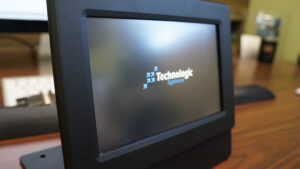You only have to go as far as your corner coffee shop to realize the new human-machine interface (HMI) preference is screens. From the touchscreen Point of Sale systems to the multitude of people interacting with their phones and mobile devices, screens are king. Industry is following suit and the choice for HMI is quickly migrating away from the keyboard and mouse and towards the screen. With the abundance of touch screens on the market and the decrease in costs there has been a marked increase in their market share and penetration. When picking a screen it’s important to determine which is better for your purposes: capacitive or resistive? Home
Resistive
Resistive screens are composed of layers separated by thin air gaps. The top layer is typically a scratch resistant plastic and the lower layer is a firmer plastic or glass. Both layers are coated with electrically conductive and resistive layers and separated by invisible separator dots. When in operation a current is moving between the layers. When pressure is applied to the top layer of the screen the layers are pressed together, causing a change in current and the touch is registered. Resistive touchscreens have a high number of sensors per square inch, therefore, a finer tip will work well on resistive touchscreens and no specialized stylus is required. Because they are sealed, resistive screens are able to offer a higher resistance to dirt, debris, and the elements. Resistive screens do come with a few cons that need to be considered when deciding if they are appropriate for your application. Because of the air gap and multiple layers, you do often sacrifice screen brightness, contrast, and clarity. Low sensitivity means that the user must push harder to close the gaps, which could sometimes create a dead zone where pressure was applied in frequently used areas of the screen. While resistive screens are less susceptible to the elements, if the screen gets severly scratched or cracked it will typically impede performance. Because the screen can only register one point of contact it does not support multi-touch or gestures.
Resistive Pros
- Will recognize finger, gloved hands or stylus
- Stylus does not need to be specialized
- High resistance to dust and elements
- Well suited for handwriting
- Typically higher sensor resolution so ideal for smaller buttons or fine tips
Resistive Cons
- Low sensitivity so you must press harder
- Sometimes poor contrast due to multiple layers
- No support of multi-touch
- Dead zones can appear in frequently used areas
- Damage to screen will typically stop performance
Capacitive
Capacitive screens rely on the electrical impulses of the human body to detect when and where a screen has been touched. Because only the slightest pressure is required, the touch sensitivity and multi-touch support are large advantages for the capacitive screen. Capacitive screens are much brighter and sharper because they have fewer layers and no air gaps to impede visual output. Fine cracks and scratches will not impede its performance, as evident with most mobile phone screens. The strength of capacitive screens in some cases are also their greatest weakness. With the reliance on the electrical impulse to complete the circuit most gloves will interfere with input, and they are only compatible with a very specific capacitive stylus. The enhanced sensitivity and ability to support multi-touch increase the chances of an inadvertent touch.
Capacitive Pros
- Multi-touch and gesture (pinch, zoom, etc.) support
- Incredibly touch sensitive
- Much brighter and sharper display
- Not prone to dead zones regardless of frequency of use
- Fine cracks and scratches do not impede performance
Capacitive Cons
- Gloves interfere with input
- Special stylus with conductive tip required
- Potential for more inadvertent touches
Conclusion
Ultimately how you are going to use your touchscreen will determine if you need to go with a resistive or capacitive screen. If you are still unsure, contact Technologic Systems at (480) 837-5200 and we can discuss your application and determine which screen is most appropriate.
Regardless of your decision, Technologic Systems has the right screen for your application. The Touch Panels designed by Technologic Systems are low-cost, industrial-grade, WVGA touchscreen computers with audio codec and speaker in a variety of enclosures and display stands. Home

